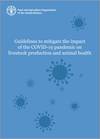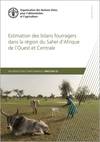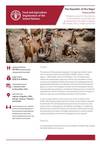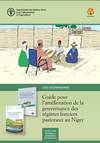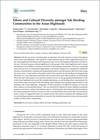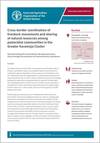Guidelines to mitigate the impact of the COVID-19 pandemic on livestock production and animal health
The purpose of these guidelines is to describe the impact of COVID-19 on livestock production and animal disease prevention and control, and to provide practical recommendations for actors along value chains to reduce this impact and ensure continuity of the livestock supply chain and animal health. The target beneficiaries of these guidelines are livestock value chain actors including livestock farmers, slaughterhouse workers, animal product processors, traders, animal health professionals and paraprofessionals, policy makers and other relevant stakeholders.
Year of publication: 2020Organization: Organisation des Nations Unies pour l'alimentation et l'agriculture (FAO)
Topic: Sécurité alimentaire
Language: English
Type of document: Technique
Geographical coverage: Global
Un bilan fourrager évalue les ressources en aliments pour animaux, y compris les fourrages, et les compare aux besoins des animaux d’élevage. Il fournit des informations aux décideurs politiques, aux producteurs et aux acteurs du secteur de l’élevage en général afin d’améliorer leur planification et leur évaluation du secteur. Dans la région du Sahel, le bilan fourrager est un outil essentiel pour les systèmes d’alerte précoce. Il est conçu et utilisé par les services techniques des pays sahéliens comme outil prospectif établi en fin d’année pour couvrir la saison sèche à venir. Ces directives pour établir des bilans fourragers tiennent compte des spécifictés des systèmes pastoraux et agropastoraux du Sahel que sont la saisonnalité des disponibilités fourragères et des performances animales, la part majoritaire des fourrages grossiers dans les rations et la mobilité des animaux et des pasteurs.
Year of publication: 2020Organization: Organisation des Nations Unies pour l'alimentation et l'agriculture (FAO)
Topic: Sécurité alimentaire, Innovation
Language: Français
Type of document: Technique
Geographical coverage: Afrique occidentale, Afrique centrale
Small ruminants are the main source of livelihood for the rural agropastoralists and are important assets in lowlands and highlands of Ethiopia. Transboundary animal diseases (TADs) are a significant cause of reduced production and productivity to the pastoral communities in Ethiopia. TADs like Peste des Petits Ruminants (PPR), Sheep and Goat Pox (SGP) and Contagious Caprine Pleuropneumonia (CCPP) have contributed to a high level of sheep and goat mortality, especially in lambs and kids. The “Pursuing pastoralist resilience through improved animal health service delivery” project implemented by FAO between 2014 and 2020, was designed to support the Government of Ethiopia in strengthening the surveillance system for most TADs. The project had a primary focus to implement a progressive control programme for Peste des Petits Ruminants (PPR).
Year of publication: 2020Organization: Organisation des Nations Unies pour l'alimentation et l'agriculture (FAO)
Topic: Résilience, Services sociaux
Language: English
Type of document: Technique
Geographical coverage: Afrique orientale
This technical report compiles and organises an intense shared effort to address the role of grazing in adaptation and fighting against climate change. The report collects up-to-date technical and scientific information about greenhouse gases behaviour in pastoralist systems, their emissions, their relationship with grazed ecosystems, their coping capacity and their potential to mitigate the effects of climate change.
Year of publication: 2020Organization: Auteurs individuels
Topic: Changement climatique
Language: English, Español
Type of document: Technique
Geographical coverage: Global
The outcome of the pastoral campaign in the Niger was limited, mainly due to insecurity, which is disrupting the mobility of herds in certain regions − Diffa, Maradi, Tahoua and Tillabéry. This is threatening the livelihoods of pastoralists, especially of those most vulnerable. Limited access to and availability of fodder for livestock are putting pastoral and agropastoral livelihoods at risk. Mobility restrictions for both people and goods as a result of armed group activities, and the subsequent security measures taken by authorities, contribute to limiting access to markets for pastoralists to sell their livestock or animal products (milk and cheese) as well as to resources such fodder and water to for their livestock. In 2020, FAO plans to implement a series of activities aiming at assisting pastoral households who are vulnerable to the fodder deficit and insecurity.
Year of publication: 2020Organization: Organisation des Nations Unies pour l'alimentation et l'agriculture (FAO)
Topic: Conflit, Sécurité alimentaire, Résilience
Language: English, Français
Type of document: Technique
Geographical coverage: Afrique occidentale
Ce guide constitue un outil à destination des acteurs de terrain au Niger. Il vise à contribuer à l'amélioration de la gouvernance foncière pastorale et en particulier à la prévention et à la résolution des conflits et au développement de processus de concertation inclusifs.
Le guide est unique car il est élaboré en collaboration avec un pour les éleveurs au Niger. Il sera un outil concret pour aider les acteurs à résoudre les conflits liés à l'accès aux ressources naturelles au niveau local.
Year of publication: 2020Organization: Organisation des Nations Unies pour l'alimentation et l'agriculture (FAO)
Topic: Conflit, Les savoirs autochtones, Régime foncier, Participation
Language: Français
Type of document: Technique
Geographical coverage: Afrique occidentale
Yak herding plays an important role in the domestic economy throughout much of the Asian highlands from Russia and Kyrgyzstan in the west to the Hengduan Mountains of China in the east. Yak also has great cultural significance to the people of the Asian highlands and is closely interlinked to the traditions, cultures, and rituals of the herding communities. However, increasing issues like poverty, environmental degradation, and climate change have changed the traditional practices of pastoralism, isolating and fragmenting herders and the pastures they have been using for many years. Local cultures of people rooted in the practice of yak herding are disappearing. Therefore, it is very important to document the socioeconomic and cultural aspects of yak herding. The broad aim of this paper was to provide a brief overview on the geographical distribution of yak in the Asian highlands and to provide in-depth information on yak-herding ethnic communities, the sociocultural aspect associated with yak herding, and challenges and emerging opportunities for yak herding in the Asian highlands. Altogether, 31 ethnic groups in 10 different countries of Asia and their cultures are documented herein. Yak was found to be utilized for many different household purposes, and to have cultural and religious aspects. Unfortunately, yak rearing and related traditions have been losing their charm in recent years due to modernization and several other environmental issues. Lastly, we suggest that there is an urgent need to take action to minimize the challenges faced by yak-herding mountain communities to conserve the traditional pastoral system and associated cultures of these ethnic communities.
Year of publication: 2020Organization: Auteurs individuels
Topic: Peuples autochtones
Language: English
Type of document: Scientifique
Geographical coverage: Asie centrale
The Greater Karamoja Cluster (GKC) encompasses the southwestern parts of Ethiopia, northwestern Kenya, the southeastern parts of South Sudan and northeastern Uganda. Though livestock is a crucial livelihood asset, the region is poorly integrated into national livestock marketing systems and conspicuously absent from the vibrant business of livestock exports from the Horn of Africa.
Year of publication: 2019Organization: Organisation des Nations Unies pour l'alimentation et l'agriculture (FAO)
Topic: Participation, Résilience
Language: English
Type of document: Politiques et législation
Geographical coverage: Afrique orientale


